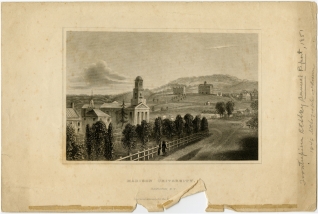tration were the Treasurers of the University and the Education Society. Professor Philetus B. Spear, Class of 136, who had been appointed University Treasurer in 1864, continued in that office until 1888. He had a well-deserved reputation for shrewdness, thrift, industry, and energy in the solicitation of funds. Through his management, and with the cooperation of James B. Colgate, the University added several acres to the campus to extend the northern boundary to its present limit.
Spear’s immediate successors were James W. Ford, ’73, former teacher and Principal of Colgate Academy (the Academic Department or Grammar School), who served from 1888 to 1889, and William R. Rowlands, ’74, who was in office from 1889 to 1896.
Deacon Alvah Pierce, University Trustee, 1846-47, 1850-91, and Treasurer of the Education Society since 1837, completed his 50 years of service in 1887. His successor was Hinton S. Lloyd, Class of 1856, and a graduate of the Seminary in 1858, who, following pastorates in New York State, had already been the Society’s Corresponding Secretary since 1877. On being appointed Treasurer ten years later he carried on in both capacities until 1907 when he retired as Treasurer but continued as Corresponding Secretary until 1915. He, like Spear, was astute, industrious, and had a painstaking zeal for ministerial education.
Financing the University in the Dodge period posed few problems, thanks in large part to Treasurer Spear’s frugal management and the generosity of James B. Colgate and members of his family. Mr. Colgate enjoyed making his donations as, for example, the “Arizona”
gift of $50,000 for endowment. This was a free-will thank-offering made in 1880 “to recognize God’s providence”
in preserving that steamship on which he had been a passenger when she was en route to Liverpool the previous November and seemed sure to founder after striking an iceberg. This gift and others helped to raise the total endowment of $177,000 in 1869 to $539,000 in 1890. Annual income from student fees, investments, and other sources for the same period rose from $23,000 to $40,000 while annual expenditures showed an increase from $25,000 to $36,000. For 11 out of the 22 years of the period there were modest deficits. In the early 1870’s the Grammar School shared in the Literature Fund as distributed by the Regents of the University of the State of New York.





